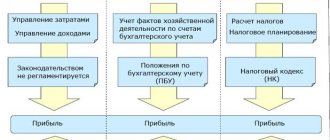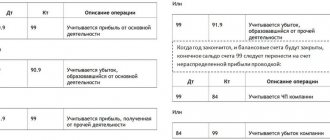Accounting for financial results is necessary to assess the economic life of an enterprise. Using these indicators, you can analyze the efficiency of the enterprise as a whole and develop a further strategy for behavior in the market, therefore, correct accounting of financial results is very important from an economic point of view.
What is a financial result?
Financial result from ordinary activities in accounting
Accounting for financial results from other activities of the organization
How to determine the final financial result?
Accounting for the use of profits
Analysis of the financial results of the organization's activities
Results
What is a financial result?
Financial result is the economic result of the economic life of an organization, which is expressed in the form of profit or loss. Profit is the amount by which revenue received exceeds expenses incurred. Simply put, when the company remains “in the black”. When an organization has incurred more expenses than it has earned from its activities, it is said to have received a loss. Information about financial results is important not only for internal control and management, but also for external parties interested in information of this kind. These include banking organizations that issue borrowed resources for use by the company at certain interest rates, insurance companies, property insuring organizations, investors investing in the development of the company, and others.
Profit is a relative measure of a company's performance. In general, it symbolizes the positive result of the enterprise. But based on profit analysis, different conclusions can be drawn. For example, after conducting a comparative analysis of profits over several years, a specialist can draw a conclusion about an increase or decrease in its value and an increase or decrease in the efficiency of the company.
The resulting loss signals the company's management about the inefficiency of commercial activities and the need to take measures to increase the company's profitability.
For effective analysis, it is important to organize timely and accurate accounting of the financial results of the organization.
Financial result from ordinary activities in accounting
The types of activities that are fixed in the constituent documentation can be classified as ordinary. Account 90 is intended for recording financial results. It is more convenient to maintain “ordinary” income and expenses in subaccounts opened to it:
- 1 - “Revenue”.
- 2 - “Cost of sales”.
- 3 - “VAT” (sales or “output” VAT).
- 4 - “Excise taxes”.
- 9 — “Profit/loss from sales.” It is in this subaccount that the final result of accounting for financial results is summarized.
Accounting for financial results from the normal activities of an organization can be represented by the following accounting entries:
- Dt 62 Kt 90.1 - sales revenue accrued;
- Dt 90.3 Kt 68 - VAT charged;
- Dt 90.2 Kt 20 (41, 43, 44) - reflects the cost of products, works or services.
Read about the features of accounting for production expenses in our article “Main production in the balance sheet (nuances).”
How to determine whether a company has made a profit or a loss? To do this, you need to compare the total turnover on the debit of accounts 90.2, 90.3, 90.4 with the turnover on credit 90.1. If the credit of the account 90.1 is greater than the debit turnover, then the company can record a profit: Dt 90.9 Kt 99. If the result is the opposite, then they speak of a loss received: Dt 99 Kt 90.9. Note that at the end of the reporting period there should be no balance on account 90.
What is the result of the company's work?
This indicator depends on the volume of sales of goods/services, the productivity of the company's property, income from transactions not related to sales and many other indicators. The financial result can be expressed as follows: the company receives either income or loss. Therefore, the activities of the enterprise are considered as:
- Profitable if the income received covers the costs incurred;
- Unprofitable when costs (production and other) exceed income.
However, they begin to analyze the company’s activities after they have already received the results of the work. We will look at how to calculate the financial result.
Accounting for financial results from other activities of the organization
If income and expenses cannot be attributed to ordinary activities, then in this case the concept of “Other types of activities” is provided for them. The list of other income consists of:
- income from the provision of property for rent;
- financial benefits from securities and other investments;
- proceeds from the sale of own assets (for example, fixed assets, intangible assets);
- gratuitous economic benefits;
- fines, penalties and penalties due, as well as compensation for damage caused;
- positive exchange rate differences;
- written off accounts payable after the expiration of the statute of limitations;
- inventory surplus, etc.
The list of other expenses is similar to income:
- cost and expenses related to the sale of assets;
- VAT on sales transactions;
- compensation for damage to third party contractors;
- fines, penalties and penalties intended for payment;
- commission of credit companies for settlement transactions;
- accounts receivable after the expiration of the statute of limitations;
- negative exchange rate differences;
- economic benefits from received loans and borrowings and others.
Others also include income and expenses arising as a consequence of emergency circumstances of economic activity: natural disaster, fire, accident, nationalization, etc. (extraordinary income and expenses).
To account for financial results from other activities, account 91 “Other income and expenses” was approved. Unlike account 90, it is enough to open only 3 subaccounts:
- 1 - “Other income”;
- 2 - “Other expenses”;
- 9 - “Balance of other income and expenses.”
The credit of account 91.1 reflects the income from other activities. It can be in correspondence with various accounts (depending on the source of income):
- Dt 62 (76) Kt 91.1 - rent accrued;
- Dt 62 (76) Kt 91.1 - accrued proceeds from the sale of assets (for example, fixed assets, intangible assets);
- Dt 62 (76) Kt 91.1 - accrued dividends, interest and other income on securities, as well as from participation in the authorized capital of third-party companies;
- Dt 66 (67) Kt 91.1 - interest accrued on previously issued long-term and short-term loans and borrowings;
- Dt 98 Kt 91.1 - income from property received free of charge is reflected;
- Dt 60 (62, 76) Kt 91.1 - accounts payable with an expired statute of limitations are written off;
- Dt 52, 57 Kt 91.1 - a positive exchange rate difference was identified when selling currency;
- Dt 63 Kt 91.1 - the amount of the reserve for doubtful debts is included in other income;
- Dt 50, 10, 41, 43 Kt 91.1 - surpluses were identified based on the results of the inventory;
- Dt 10 Kt 91.1 - materials suitable for further use remaining after damaged fixed assets, goods, finished products are capitalized;
- Dt 76 Kt 91.1 - reflects the amount of insurance compensation for destroyed property if it was insured.
And the debit of account 91.2 is intended to reflect expense transactions:
- Dt 91.2 Kt 01.2 - the residual value of fixed assets intended for sale is written off;
- Dt 91.2 Kt 04.2 - the residual value of intangible assets intended for sale is written off;
- Dt 91.2 Kt 10 - the cost of materials intended for sale is written off;
- Dt 91.2 Kt 68 - VAT is charged on transactions for the sale of fixed assets, intangible assets and materials;
- Dt 91.2 Kt 66 (67) - interest accrued on short-term and long-term loans and borrowings received;
- Dt 91.2 Kt 60 (62, 76) - expired accounts receivable written off;
For more information about the procedure for writing off receivables, read our material “The procedure for writing off receivables.”
- Dt 91.2 Kt 76 - bank commission charged for conducting settlement transactions;
- Dt 91.2 Kt 52, 57 - negative exchange rate difference is reflected;
- Dt 91.2 Kt 01.2, 10, 41, 43 - the residual value of fixed assets, materials, goods and finished products that were damaged as a result of an emergency, for example, in a fire in the warehouses of an enterprise, is written off.
The meaning of calculating the final financial result is completely similar to account 90:
- Dt 91.9 Kt 99 - profit on other operations is reflected;
- Dt 99 Kt 91.9 - loss received from other activities.
Like the score 90, the score 91 assumes there is no balance on it.
Read about the procedure for determining exchange rate differences in our article “Accounting for foreign exchange transactions (PBU, postings).”
Additionally
You noticed that in the financial result formula, I wrote down the expense part like this. At the same time, I highlighted the cost accounts in bold. Did you notice? I wanted to bring this to your attention and raise a couple of questions from you. Which?
- Why is there no 20, 25 count here when there is 26?
- Why are these accounts highlighted?
Let's take it in order.
Why is there no 20, 25 count here when there is 26
The presence of 20 and 25 accounting accounts is typical for manufacturing companies. And all firms except trading ones have a 26 account. When the procedure for “closing the month” begins for manufacturing firms, accounts 26 and 25 are closed at 20, and 20 is closed at 40.
But 40, if there are deviations between the actual price from production and the planned price at which the products arrived at the warehouse, will partially go into expenses of 90.2 for the goods sold and 43. Probably, the result is a complex proposal. To fully understand it, it will be necessary to analyze production in detail. This is the task of other materials.
For manufacturing enterprises, to obtain the cost of production, all expenses are collected into account 20. But what is included in the financial result formula? Only the cost of goods sold at the time of sale is included. And also expenses from account 44.
Then what does the 26th account in the financial result formula tell us? The presence of account 26, which transfers its amounts to account 90, is typical for companies providing services.
Why do you highlight these accounts in the formula?
Because these accounts do not exist in the formula! That's how it is! I wrote them so that you have an answer to the question “Where will the amounts from the accounts storing costs/expenses go and where will they end up?” These amounts will be in the financial result formula, but will be transferred there to the appropriate subaccounts.
Amounts from cost/expense accounts will be transferred to subaccounts:
- 90.7 “Sale expenses”. Amounts from account 44 will come here (production and trading activities, performance of work)
- 90.8 “Administrative expenses”. Amounts from account 26 (service activities) will come here.
This is where I will end this article. All you have to do is work through it, understand the patterns, basic situations and conditions. This knowledge is enough for each time you draw up a primary document to think about how the entry made will affect the financial result of accounting.
Now in our articles on the website we only have a highlighted basis from accounting theory. The next step is to practice your accounting skills. Stay on the site. All the most interesting things are yet to come.
Strengthen your knowledge
How to determine the final financial result?
Taking into account the financial results for ordinary and other activities, we figured it out. But how to determine the overall financial result for the enterprise as a whole? First, let's define what it consists of.
The final financial result includes:
- financial result obtained from ordinary activities;
- financial result identified from other activities;
- accrual of income tax.
The result of accounting for financial results for ordinary activities is reflected:
- Dt 90.9 Kt 99 - profit;
- Dt 99 Kt 90.9 - loss.
The balance of accounting for financial results for other activities is as follows:
- Dt 91.9 Kt 99 - profit on other operations is reflected;
- Dt 99 Kt 91.9 - loss received from other activities.
Income tax is required to be assessed and paid by Russian and foreign companies that operate within the territory of our country and apply the general tax regime. It is reflected in the following entry in the accounting accounts:
Dt 99 Kt 68.4 - income tax is charged, which is intended to be transferred to the budget system of the Russian Federation.
You can learn how to determine the amount of income tax from the publication “How to correctly calculate corporate income tax?”.
For the entire financial year, the balance of profits and losses in accounts 90 and 91, as well as accrued income tax, are accumulated in account 99. At the end of each year, the result of accounting for financial results is determined and final entries are made using account 84 “Retained earnings (uncovered loss)”:
- Dt 99 Kt 84 - net profit received.
- Dt 84 Kt 99 - the loss of the financial year is reflected.
Thus, account 99 is completely closed at the end of the year and cannot have a balance.
Reflection of financial results in financial statements
To reflect the income, expenses and financial results of the organization, Form No. 2 of the financial statements “Profit and Loss Statement” is used.
In the Profit and Loss Statement, data on income, expenses and financial results are presented on an accrual basis from the beginning of the year to the reporting date. The procedure for presenting data in the profit and loss statement depends on the organization’s recognition of income based on the requirements of PBU 9/99 “Income of the Organization”, expenses based on the requirements of PBU 10/99 “Expenses of the Organization”, as well as the nature of the activity.
The profit and loss statement includes a breakdown of individual profits and losses, which provides data for the reporting period and for the same period of the previous year on certain types of profits and losses:
- · fines, penalties, penalties, recognized or for which court decisions on their collection have been obtained;
- · profit (loss) of previous years;
- · compensation for losses caused by non-fulfillment or improper fulfillment of obligations;
- · exchange rate differences on transactions in foreign currency;
- · contributions to valuation reserves;
- · write-off of receivables and payables for which the statute of limitations has expired.
Individual items that are not significant enough to require separate presentation in the Income Statement may be significant enough to be presented separately in the notes to the Income Statement.
An indicator is considered significant if its non-disclosure may affect the economic decisions of interested users made on the basis of the reporting information. The organization's decision on whether an indicator is significant depends on the assessment of the indicator, its nature, and the specific circumstances of its occurrence. An organization can make a decision when an amount is considered significant if its ratio to the total of the relevant data for the reporting year is at least 5 percent.
Column 4 of the Profit and Loss Statement “For the same period of the previous year” for the reporting year is filled out based on the data in Column 3 “For the reporting period” of the Report for the previous year. At the same time, comparability of data for the same period of the previous year with data for the reporting year must be ensured7. If these data are not comparable, then the data for the period preceding the reporting year are subject to adjustment.
All expenses of the organization, as well as indicators with negative values, are reflected in parentheses in the Profit and Loss Statement.
Let's look at filling out the profit and loss report item by item.
Income and expenses from ordinary activities.
Line 010 “Proceeds (net) from the sale of goods, products, works, services (less value added tax, excise taxes and similar mandatory payments).” This article reflects revenue from the sale of products and goods, income related to the performance of work and the provision of services, and the implementation of business transactions, which are income from ordinary activities.
Despite the presence in the Profit and Loss Statement of a separate indicator “Interest receivable” (line 060), interest on a commercial loan provided to customers in the form of deferred payment should be reflected on line 010 “Revenue”. According to PBU 10/99, when selling goods (work, services) on the terms of a commercial loan, the proceeds are taken into account in the amount of accounts receivable along with accrued interest.
Income recognized in accounting as income from ordinary activities, if it is significant or without knowledge of which it is impossible for interested users to assess the financial results of the organization’s activities, must be reflected separately:
- · in the form of a transcript to the article “Proceeds (net) from the sale of goods, products, works, services (less value added tax, excise taxes and similar mandatory payments)”;
- · in the appendix to the profit and loss statement.
In both cases, the organization independently develops and adopts a reporting form on a long-term basis.
Line 020 “Cost of goods, products, works, services sold.”
This line reflects the amount of expenses for ordinary activities associated with the manufacture and sale of products, the acquisition and sale of goods, the performance of work, and the provision of services.
If an organization, in accordance with its accounting policy, recognizes management expenses entirely in the cost of goods sold, products, work performed, services rendered as expenses for ordinary activities, this item reflects the costs of producing sold products, works, services, excluding general production expenses.
The amount in line 020 when calculating the final indicators is taken with a minus sign, therefore it should always be enclosed in parentheses in the Profit and Loss Statement.
Line 029 “Gross profit”. The value of this line is determined as the difference between the data in line 010 “Revenue (net) from the sale of goods, products, works, services (minus value added tax, excise taxes and similar mandatory payments)” and the data in line 020 “Cost of goods, products sold, works, services.” Line 030 “Business expenses”. Expenses associated with the sale of products from organizations not engaged in trading activities, and distribution costs from organizations engaged in trading activities, are not reflected in line 020 “Cost of goods, products, works, services sold”, but are shown in the article “Commercial expenses” of the report about profits and losses.
A chart of accounts for summarizing information on expenses associated with the sale of products, goods, works and services, that is, commercial
expenses, account 44 “Sales expenses” is intended.
The amount on line 030 is reflected in the Profit and Loss Statement in parentheses.
Line 040 “Administrative expenses”. This line is filled in if the organization, in accordance with its accounting policy, writes off general business expenses at a time from the credit of account 26 “General business expenses” to the debit of account 90.2 “Cost of sales”. The indicator for this line is reflected in the Profit and Loss Statement in parentheses.
Line 050 “Profit (loss) from sales.” Profit (loss) from sales is the difference between the indicator of line 029 “Gross profit” and the indicators of lines 030 “Commercial expenses” and 040 “Administrative expenses”. If a negative value is obtained, the organization has incurred a loss on sales. In this case, the indicator for this line is reflected in parentheses.
Other income and expenses.
Line 060 “Interest receivable”. This line reflects the amount of interest due to the organization on purchased (received) bonds and bills, bank deposits, and issued loans and credits.
Line 070 “Interest payable”. This line reflects other expenses in the amount of interest due on bonds, shares, loans and borrowings received. The indicator for this line in the Profit and Loss Statement is reflected in parentheses.
Line 080 “Income from participation in other organizations.” This line reflects income from participation in the authorized capitals of other organizations, as well as from participation in joint activities.
Line 090 “Other income”. This line reflects other income provided for by Accounting Regulations 9/99 “Income of the organization”.
Line 100 “Other expenses”. This line reflects other expenses provided for by Accounting Regulations 10/99 “Expenses of the organization”. The value of this line is subtracted when calculating the totals, therefore it is indicated in parentheses in the Profit and Loss Statement.
Line 140 “Profit (loss) before tax” reflects the indicator calculated as the sum of lines 050 “Profit (loss) from sales”, 060 “Interest receivable”, 080 “Income from participation in other organizations”, 090 “Other income” minus lines 070 “Interest payable” and 100 “Other expenses”. If the calculation results in a loss, then the amount on line 140 is reflected in parentheses.
Line 141 “Deferred tax assets”. This line reflects deferred tax assets accrued and repaid during the reporting period. The indicator for this line is formed as the difference between debit and credit turnover in account 09 “Deferred tax assets”.
Line 142 “Deferred tax liabilities.” This line reflects the amount of deferred tax liabilities accrued and repaid during the reporting period. The indicator for this line is formed as the difference between credit and debit turnover in account 77 “Deferred tax liabilities”8.
Next, the Profit and Loss Statement reflects the current income tax (line 150), additional indicators (line 151) and calculates the net profit (loss) of the reporting period of the organization (line 190).
The indicator of line 190 “Net profit (loss) of the reporting period of the organization” is calculated as follows:
Line 140 “Profit (loss) before tax” + line 141 “Deferred tax assets” - line 142 “Deferred tax liabilities” - line 150 “Current income tax”.
After calculating the amount of net profit, a number of reference indicators should be indicated in the Profit and Loss Statement. In sample form No. 2 “Profit and Loss Statement”, recommended in Order of the Ministry of Finance of the Russian Federation No. 67n “On Forms of Accounting Reports”, it is proposed to reflect in the reference section:
- · permanent tax obligations - line 200;
- · basic profit (loss) per share - line 201;
- · diluted earnings (loss) per share - line 202.
The organization has the right to add additional lines to the Profit and Loss Statement and provide in the reference section other additional information that is necessary for interested users of the financial statements.
Accounting for the use of profits
Profit is a positive result of the company's activities as a whole. Every enterprise is interested in increasing it. But making a profit alone is not enough for the further development of the organization. Its rational and effective use is of great importance. Net profit is the profit remaining at the disposal of the enterprise after paying income tax. It is reflected in the credit of account 84 and is subject to further distribution.
Find out how to analyze a company’s net profit from our article “Procedure for analyzing a company’s net profit.”
The main directions of distribution of net profit:
- Creation of reserve capital. For joint-stock companies, its creation is a prerequisite; other enterprises can create it at their discretion:
Dt 84 Kt 82 - reserve capital was formed at the expense of net profit.
- Repayment of losses from previous years:
Dt 84 Kt 84 - the loss of previous years is repaid.
- Accrual and payment of dividends to company participants:
Dt 84 Kt 75 (70) - dividends are reflected.
Account 70 is used when the shareholders are employees of the enterprise.
Based on the results of the financial year, the enterprise may receive a loss, which is also reflected in account 84. It can be covered in several ways:
- Using additional capital:
Dt 83 Kt 84.
- At the expense of the amount of reserve capital that was created in previous reporting periods after the distribution of net profit:
Dt 82 Kt 84.
- Due to additionally attracted contributions from company participants:
Dt 75 (70) Kt 84.
Thus, the rational use of profits allows the enterprise to remain more sustainable in the future. Modern economists consider the creation of reserve capital to be one of the most effective ways to use net profit. It will help the company in the future to cover losses from its activities, which are possible in an unstable economic situation.
How accounting is built
Accounting is based on the financial calculation formula. results: FR = FRp + FRpr - N + SHE - IT - ShP , where:
- FR – final financial. result;
- FRp – profit (loss) from sales;
- FRpr - the same from other types of activities;
- N – tax (on profit);
- OTA – deferred tax assets;
- IT – the same thing – obligations;
- ShP – the amount of sanctions for violation of legislation in the field of NU.
Instructions for using the chart of accounts require taking into account profits and losses on account 99 BU . The debit will reflect the company's expenses and losses, and the credit will reflect the company's income and profit. Comparing debit and credit turnovers, we obtain a financial result. If a profit is made, it will be recorded under credit 99. This profit must be reduced by the amount of the corresponding tax and the amount of sanctions (if they were applied to the organization). The indicated amounts are recorded as debit 99.
On a note! PBU 18/02 R.4 defines the amount of income tax as a conditional expense (income), depending on the amount from which it was determined: profit or loss.
The main entries for account 99 reflect:
- Dt 90 (99) Kt 99 (90) – write-off of profit (loss);
- Dt 91 (99) Kt 99 (91) – write-off of the balance of profit (loss) on other income and expenses.
In addition, in accordance with the formula, conditional expenses associated with income tax, tax sanctions, liabilities, and income tax recalculations may be reflected here.
Account 99 corresponds at the end of the year with account 84 (“Retained earnings/uncovered loss”), depending on the financial receipts. result (page 2400 of the Financial Results Report):
- Dt 99 Kt 84 - if profit is made;
- Dt 84 Kt 99 - if there is a loss.
The company's main activity, by default, brings in the lion's share of income that affects profit.
To record business transactions during the year, account 90 “sales” is used here, and subaccounts are opened for it, specifying the accounting. Credit 90 reflects sales revenue at sales prices, and debit:
- cost of products sold;
- VAT on goods sold;
- excise taxes.
Subaccounts of account 90: 1 - revenue, 2 - cost of sales, 3 - VAT, 4 - excise taxes, 9 - profit (loss) from sales. Monthly revenue and the amount of expenses (cost, VAT, excise taxes) are compared with each other and a financial result is revealed, which is reflected in subaccount 9 and written off every month to profit (loss): Dt 90/9 Kt 99 - profit, Dt 99 Kt 90/9 - loss.
Let's give an example of reflecting transactions on account 90 “Sales”. Let (conditionally): revenue for the period amounted to 2,000,000 rubles, VAT - 20%, including the cost of products - 900,000 rubles, sales costs - 50,000 rubles. Income, according to the accounting policy, is recognized on shipment.
Postings:
- Dt 62 Kt 90/1 - 2000000.00 - sales revenue is taken into account.
- 2000000:1.2 = 1666666.67. 2000000-1666666.67= 333333.33. Dt 90/3 Kt 68 - 333,333.33 - VAT charged.
- Dt 90/2 Kt 43 (or 41) - 900,000.00 - cost written off.
- Dt 90/2 Kt 44 - 50,000.00 - selling expenses.
- 333333.33 + 900000.00 + 50000.00 = 1283333.33. 2000000.00 – 1283333.33 = 716666.67. Dt 90/9 Kt 99 716666.67 - profit from sales is taken into account.
Other income/expenses are accounted for in account 91. Subaccounts are usually used here: 1 - income, 2 - expenses, 9 - balance of income/expenses, and the financial result is determined by comparing credit turnover in subaccount 1 and debit in subaccount 2.
The monthly postings will be as follows:
- Dt 91/1 (91/9) Kt 91/9 (91/2) – the balance of other income (expenses) is written off.
- Dt 91/9 (99) Kt 99 (91/9) – at the end of the month, profit (loss) from other activities was recorded.
Income tax is calculated and transferred using a separate subaccount. 68:
- Dt 99 Kt 68/profit;
- Dt 68/profit Kt 51.
By analogy, the sanctions mentioned above are also taken into account.
Analytics on financial accounts. results is formed in order to ensure transparency of the data necessary to work with the profit and loss account and balance sheet indicators. To increase analyticality, for example, separate accounts can be opened on account 99: 1 - profits/losses from ordinary activities, 2 - similarly from operating activities (identified on account 91), 3 - from non-operating transactions (also identified on account 91), 6 – income tax payments, sanctions, etc.
All these points must be reflected in the accounting policy, and a working chart of accounts must be adopted. It would be useful to indicate in this document how to use the resulting net profit:
- consolidation of authorized capital;
- dividend payment;
- capital investments;
- repayment of losses from previous periods, etc.
They are reflected in various entries, for example: Dt 84 Kt 84 - the loss of previous years is repaid; Dt 84 Kt 75 (or 70 if we are talking about an employee) - dividends are reflected.
Losses are covered by reserve, additional capital, and attraction of deposits from participants under Kt 84 accounts.
Analysis of the financial results of the organization's activities
The financial result of the financial year shows the effectiveness of the commercial activities of the enterprise. Timely and complete accounting of financial results is important from an economic point of view, as it allows you to obtain the most reliable data and conclusions. Analysis allows you to identify the weaknesses of the enterprise and find a more rational use of available resources. Analysis data can be used for current and strategic planning of the company's activities in the future.
The main purpose of analysis, as well as accounting for financial results, is to assess the state of the enterprise as a whole. Such data is necessary not only for the management of the enterprise, but also for the company specialists responsible for its further development. Basically, the analysis uses a deductive method, that is, a movement from general data of accounting for financial results to specific ones.
Accounting for financial results involves the preparation and submission of financial statements. Profit occupies one of the key places when carrying out analytical calculations. A distinction is made between the analysis of accounting and economic profits of an enterprise. The difference between them lies in the manner in which profit is determined.
The calculation of accounting profit is based on accounting data. It is this profit that we see in the income statement. Accounting profit recognizes only explicit costs for real and documented business transactions. When determining economic profit, experts also take into account implicit costs. Because of them, the difference between accounting and economic profit is formed. Implicit costs represent alternative resources or lost economic opportunities (benefits). For example, a company has a savings deposit with a credit institution. If it had additionally invested certain financial resources into it during the year, then the income on the deposit could have increased. The amount of possible, but not received interest on the deposit will be lost economic profit.
Each type of profit can be analyzed using basic techniques:
- Comparative analysis, which involves comparing the same indicators over similar periods of time, and also reveals deviations between them, up or down.
- Structural analysis aimed at calculating the structure of each indicator in the total weight of all data and the dynamics of its change.
- Factor analysis, which is used to determine the influence of each factor on the economic result and identify the relationships between them.
Each enterprise that is interested in further increasing profits must choose those analysis methods that best suit its specific activities and industry.
Formulas for calculating the main indicators that characterize the company’s activities can be found in the article “Basic financial ratios and formulas for their calculation.”
Writing off accounts receivable to the financial result
Published in the issue: Accountant Consultant N2 / 2002
As the experience of conducting audits shows, in the accounting records of many enterprises, accounts receivable from many years ago are listed in accounts 60 “Settlements with suppliers and contractors”, 62 “Settlements with buyers and customers”, 71 “Settlements with accountable persons”, 73 “Settlements with personnel for other operations”, 76 “Settlements with other debtors and creditors”.
Part of the total amount of debt is overdue, the other part is unrealistic for collection. According to current legislation, if accounts receivable are subject to write-off for financial results, then they should be written off, otherwise net profit is distorted, which directly affects the interests of the owners (shareholders), and the balance sheet of the enterprise also becomes unrealistic.









